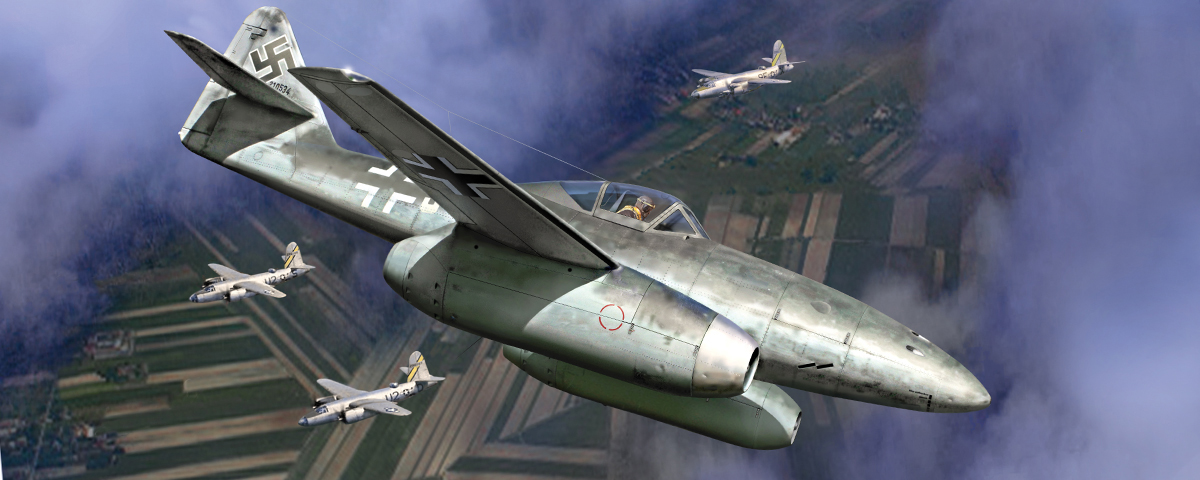With his slicked-back black hair and matching mustache, broken nose and perennial cigar, Lieutenant General Adolf Galland was the personification of the Luftwaffe fighter arm during World War II. His Messerschmitt 109s bearing the incongruous Mickey Mouse emblem became iconic images for generations of historians, artists and modelers. Yet those were superficial manifestations of his personality; the man beneath the image was far more intriguing.
Galland was born into a western German family of French descent in March 1912. His father was fortunate to survive World War I, losing seven brothers between 1914 and 1918.
The second of four sons, Adolf Jr. was enamored with aviation from childhood. He joined a glider club and soloed at 17, calling the experience “the most important moment of my life.” As he summarized, “The saying that the gods demand sweat and tears before they grant success has no truer application than in the sport of gliding.”
Galland’s success led to qualification for Lufthansa, the national airline, in 1932. He was among 18 pilots accepted from 4,000 applicants.
However, the budding airman’s career seemed to careen toward expulsion from flight school after a particularly bad landing and a collision between two friends while Galland led an unauthorized formation flight. At that point, expecting the worst, he applied to Germany’s small army and was accepted, but Lufthansa refused to let him go. “The incident was soon forgotten and I breathed freely again,” he said.
After a brief stint piloting flying boats, in 1933 Galland was recruited into a clandestine program designed to build a new German air force. His detachment went to Italy for military flight training before returning to Lufthansa. The instrument experience he gained flying transports later proved invaluable.
In October 1935 Galland crashed severely in a Focke-Wulf Fw-44 trainer. Comatose for three days, with a fractured skull and nose, he returned to flight status with the help of a friendly flight surgeon. But Galland suffered another serious wreck a year later, revealing an eye injury from the previous episode. He passed the subsequent examination by memorizing the eye chart.
Welcoming a shot at combat, in 1937 Galland joined the Condor Legion, which Adolf Hitler had dispatched to support Spanish Generalissimo Francisco Franco’s Nationalists against Republican forces. There Galland logged some 300 ground-support missions in 10 months, largely flying Heinkel He-51 biplanes. Before leaving Spain he flew the new Messerschmitt Bf-109, checked out by Werner Mölders, the Condor Legion’s most successful fighter pilot, with 14 victories to his credit.
Spain had marked a transition in combat aviation, from open-cockpit biplanes to all-metal monoplanes. Decades later Galland joked, “In open cockpits sometimes you could not only hear the enemy—sometimes you could smell him!”
Upon his return from Spain in 1938, Galland spent several months in the air ministry, helping formulate doctrine for what would become the Blitzkrieg. It was a significant assignment for one so junior, reflecting the leadership’s confidence in Galland and his expertise at close air support.
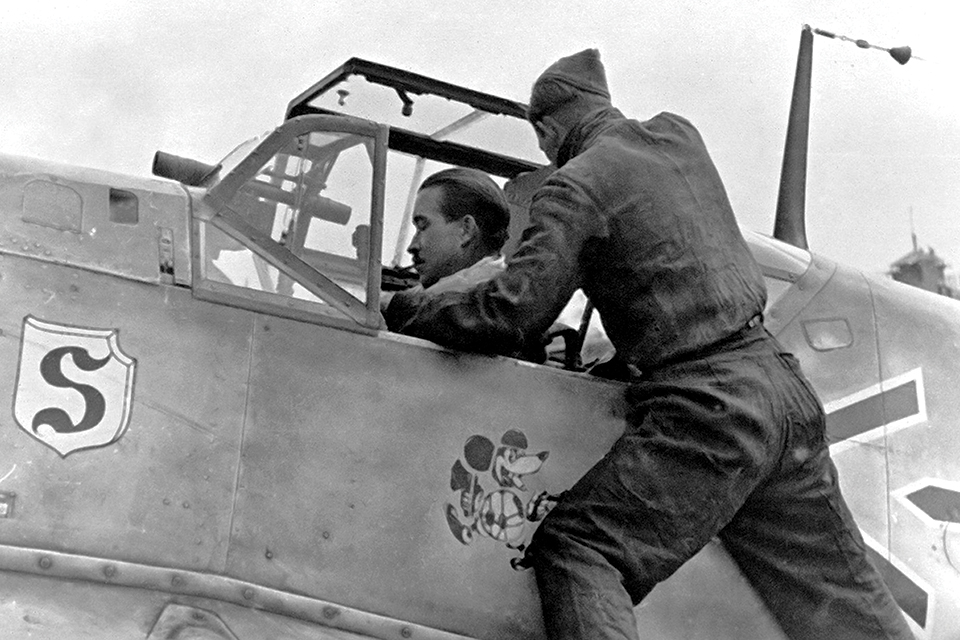
With that background, Galland led dozens of close-support missions in Henschel Hs-123 bi-planes in Poland at the start of WWII. However, a cloud with a golden lining emerged when Galland developed rheumatism. Unable to withstand the cold of the Henschels’ open cockpits, he transferred to fighters. Ever the hunter, he was posted to Jagdgeschwader 27 (JG.27) in February 1940, serving with that fighter wing for four months. On June 12 he claimed his first three kills, all Hawker Hurricanes, over Belgium, with two confirmed by Royal Air Force records. Years later he theorized that the third could have been Belgian.
“I took this all quite naturally, as a matter of course, for there was nothing special about it,” Galland reflected. “I had not felt any excitement, and I was not even particularly elated by my success; that only came much later, when we had to deal with much tougher adversaries, when each relentless aerial combat was a question of ‘You or me.’”
Already promoted to captain, Galland transferred to JG.26 in June, and was credited with 14 victories when the Battle of Britain began in July. By then he was a major commanding the wing’s III Gruppe.
Germany’s ill-fated effort to bomb Britain into a negotiated settlement floundered on the rocks of reality in the summer of 1940. The Luftwaffe, built primarily as an army support organization, lacked the strategic punch and reach to destroy British industry. Consequently, the Battle of Britain centered on Germany’s effort to defeat RAF Fighter Command over southeastern England.
A doctrinal dispute quickly arose. Alarmed by bomber losses, Luftwaffe chief Hermann Göring, a WWI ace, ordered his Messerschmitts to fly close enough to the Heinkels and Dorniers for the crews to see the friendly fighters.
Galland recognized the folly of Göring’s bomber close-escort requirement. “We fighter pilots certainly preferred the ‘free chase’ during the approach and over the target area,” he said. “This in fact gives the greatest relief and the best protection for the bomber force, though not perhaps a direct sense of security. A compromise between the two possibilities was ‘extended protection’ in which the fighters still flew in visible contact with the bombers, but were allowed to attack any enemy fighter which drew near the main force.
“In addition, we introduced ‘fighter reception’: fighter squadrons or wings which sometimes went right up to the English coast to meet the often broken-up and battered bomber formations on their return, protecting them from pursuing enemy fighters.”
The twin-engine Messerschmitt 110 was intended to provide long-range escort to the bombers. Galland summarized: “Our protective role should have been allotted to the more suitable Me 110, a machine specially created for the tasks which fighters were not up to on account of their small radius. But soon it was clear that the Me 110 was even less suited than the 109.”
Seeking better results, Göring replaced most of his WWI comrades with new blood in tactical commands. Galland assumed leadership of JG.26 in August, and before year end he was a lieutenant colonel. By then the RAF advantages were well known. Comparing British and German situational awareness, he noted: “We had to rely on our human eyes. The British fighter pilots could rely on the radar eye, which was far more reliable and had a longer range. When we made contact with the enemy, our briefings were already three hours old; the British only as many seconds old—the time it took to assess the latest position by means of radar to the transmission of attacking orders from Fighter Command to the airborne force.”
Still, by the end of October, Galland had run up his victory tally to 49. Of the 37 credited to him during that period, about 27 appear credible based on British losses.
Galland feuded with Göring for most of the war. As he told historian Colin Heaton: “Göring had many problems, but he was basically an intelligent man and well educated. He had many weak points…and he was always under pressure from Hitler, yet he never contradicted him or corrected him on any point. This weakness increased as the war dragged on, along with his drug addiction, until he was nothing. As far as our Luftwaffe was concerned, he was even less and should have been replaced.”
The action continued over the English Channel after the Battle of Britain, often with multiple daily combats. On June 21, 1941, Galland was shot down twice. First attacking Bristol Blenheim bombers, he was caught from behind and forced to crash-land in occupied France. Several hours later, flying his spare Messerschmitt, he scrambled again and outfought a Supermarine Spitfire. But while watching it splash, he was jumped again and shot down. He barely escaped the flaming 109 in time to pull his ripcord. Returning to his French base from the hospital, he learned that his 70th victory had earned him the Oak Leaves to the Knight’s Cross—the third ever awarded.
Occasionally JG.26 clashed with the RAF’s Tangmere Wing, commanded by the legendary Douglas Bader. On August 21 the legless British ace was downed over France in a confusing combat that may have involved friendly fire. Galland hosted his opposite number before Bader entered prison camp, beginning an enduring relationship.
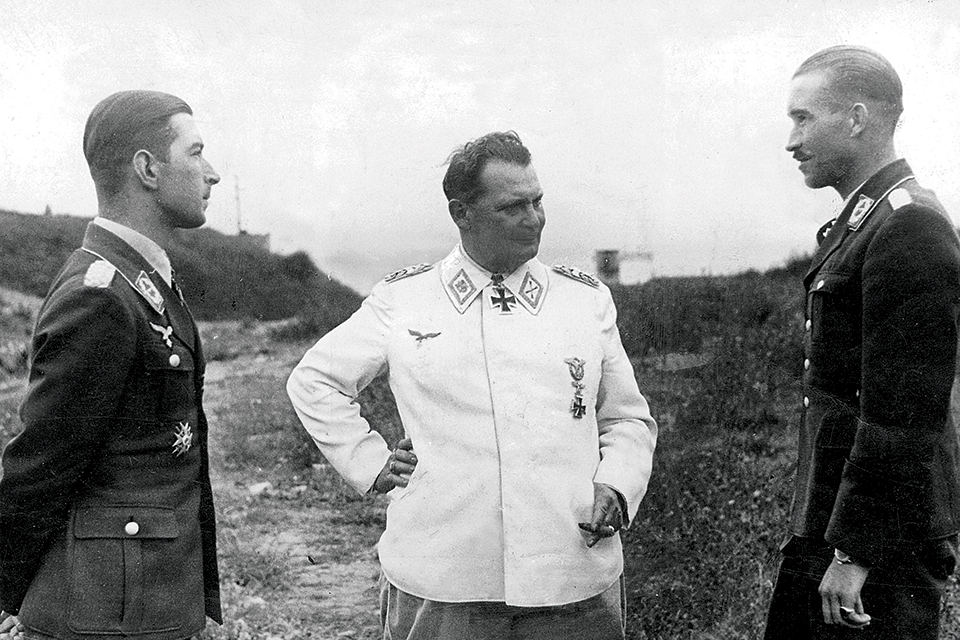
Much has been made of Galland’s rivalry with JG.51 commander Werner Mölders, though they were friends. Their careers were inextricably linked, even in death. When Mölders was killed in an accident on November 22, 1941, Galland succeeded him as Inspector of Fighters.
To Galland, the year was an unmitigated disaster. Germany had attacked the Soviet Union in June, and less than six months later declared war on the United States. With more strategic grasp than his masters, the ace recognized the war’s inevitable outcome, but could only continue doing what he knew best.
Galland was promoted to full colonel in December, retaining that rank for a year. When Göring approved the position for flag rank in late 1942, Galland became Generalmajor, an Allied one-star equivalent. Thus, at 30, he was Germany’s youngest general, rising to Generalleutnant in late 1944.
Meanwhile, in January 1942 Galland received the Diamonds to the Knight’s Cross, acknowledging his 96 victories. He was only the second Diamonds recipient, Mölders having been the first. Just 25 more were authorized during the war.
Galland’s organizational and command talents were soon evident. In February 1942 the German navy required air cover for the “breakout” of the battlecruisers Scharnhorst and Gneisenau, which with cruiser Prinz Eugen ran the British gantlet in the spectacular “Channel Dash.” Operating within easy reach of land-based airpower, the Kriegsmarine force with six destroyers and dozens of smaller escorts escaped from Brest on the French coast to German ports.
Galland’s Operation Thunderbolt was a resounding tactical success, with Luftflotte 3 protecting the ships during the three-day transit. Both battleships sustained damage from mines but safely reached port. In exchange for 22 German aircraft downed, the British lost more than 40, including all six attacking Fairey Swordfish torpedo planes.
Galland was already well known to Hitler, who lauded the operation’s success. Reflecting on the Führer, Galland said, “I don’t think anyone ever really knew Adolf Hitler. I was not very impressed with him. The first time I met him was after Spain when we were summoned to the Reichschancellery. There was Hitler, short, gray-faced and not very strong, and he spoke with a crisp language. This impression was strengthened every year I knew him as his mistakes mounted and cost German lives, the mistakes that Göring should have brought to his attention.”
Thereafter Galland traveled extensively, keeping his finger on the pulse of the Luftwaffe’s fighter force in Russia, Italy and North Africa. Occasionally he cadged unauthorized missions in Fw-190s, though his claims against U.S. bombers remain obscure.
In May 1944 the U.S. Eighth and Ninth air forces lost almost 550 aircraft over Europe, while the RAF wrote off nearly 1,000. But the momentum clearly belonged to the Allies. “The British and American tactical air forces, successfully extending their attempts to interrupt the bringing up of German reserves deep into France, made any move by daylight almost impossible,” Galland recalled. “In June alone they destroyed 551 locomotives.” He cited a panzer division commander’s report: “The Allies have total air supremacy. They bomb and shoot at anything which moves, even single vehicles and persons. Our territory is under constant observation. The feeling of being powerless against the enemy’s aircraft has a paralyzing effect.”
The Luftwaffe seldom launched more than 250 daily fighter sorties during the Normandy campaign—a losing effort. “Wherever our fighters appeared, the Americans hurled themselves at them,” said Galland. “They went over to low-level attacks on our airfields. Nowhere were we safe; we had to skulk on our own bases. During takeoff, assembling, climbing, and approaching the bombers, once in contact, on our way back, during landing, and ever after that the American fighters attacked with overwhelming superiority.”
Around the same time as the D-Day landings, the Luftwaffe debuted the world’s most advanced aircraft. When Galland first flew the jet-powered Messerschmitt 262 in early 1943 he famously reported, “It was as though the angels were pushing.” But technical and bureaucratic delays kept the jet sidelined past the point where its stunning performance could have made a difference.
While the revolutionary Me-262 went operational in July 1944, Galland opposed Hitler’s insistence on using it as a fast bomber. The fighter chief believed that it was best employed slaying bombers, but he was ignored for too long to have a significant impact against them.
Increasingly, Galland fought a two-front war: against the Allies in the air and against the Nazi hierarchy on the ground. His distressingly blunt honesty earned him powerful enemies at court.
At length Galland’s resistance to Göring ended predictably: He was dismissed as chief of fighters and placed under house arrest, pending final disposition. The Reichsmarschall added with grim satisfaction that the order had come from Hitler.
At that point Galland’s lengthy relationship with armaments minister Albert Speer paid dividends. Much later Galland learned that Speer had intervened with Hitler, fearing that Göring wanted the deposed general executed. When Speer described the situation, Hitler was enraged at the usurpation of his name, ordering Galland immediately released. Subsequently the general received an apology from the Führer, and a long monologue from Göring.
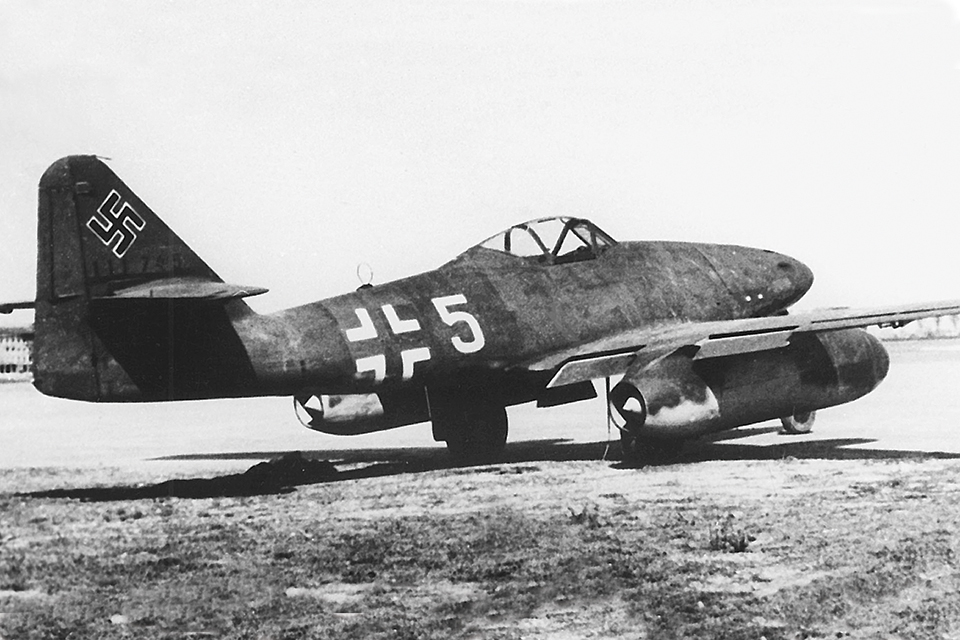
To his satisfaction, Galland was sent to southern Germany to form a jet fighter unit as an overqualified two-star wing commander. Jagdverband 44 attracted many of Galland’s outcast friends, including senior officer standouts Johannes Steinhoff and Günther Lützow.
Despite possessing more 262s, the Luftwaffe had no hope of offsetting immense Allied numbers merely with technology. In its four months of existence, JV.44 claimed 40 to 50 shootdowns—seven by the fighter general.
Contemporaries such as Steinhoff noted that Galland’s strengths tended to conceal his errors. Perhaps the most notable was his half-hearted effort to establish a fighter leaders’ school in 1943, a concession to increasing attrition among senior pilots. The concept died, in part because Galland’s own career had showed the stairway to the stars. Innate ability plus extensive experience had groomed him for ever-higher command levels, yet apparently it did not occur to him that others might not fare as well.
Galland recognized the growing proportion of operational to combat losses, especially to weather-related accidents. However, he lacked the ability to correct it. The problem was twofold: a declining fuel supply and the need to shove replacement aircrews through abbreviated training that necessarily skimped on instrument flying.
Still, the jet pilots kept flying as long as kerosene and ammunition lasted.
After scoring his 104th victory on April 26, 1945, Galland made a rookie’s mistake—watching a B-26 Marauder crash instead of immediately checking his tail. Lieutenant James Finnegan, a Ninth Air Force P-47 Thunderbolt pilot, jumped the vulnerable jet and ventilated it. Galland got the failing 262 back to base, landing amid a Thunderbolt rainstorm. He abandoned his “Turbo,” receiving a leg wound in the process.
Galland’s war was over, his world in ruins. He had lost two of his three brothers and scores of cherished friends such as Mölders and Lützow, and had seen Steinhoff severely burned in a jet crash.
Following surrender to U.S. forces, Galland and other senior Luftwaffe officers were interrogated at facilities in Britain and Germany. Galland spent two years in captivity, including a session with recent adversaries. Major Richard Petersen, a triple ace of the 357th Fighter Group, recalled, “Galland was damned smart and easy to talk to, once you got past the accent. I enjoyed getting to know him.” Galland’s former RAF rival, Wing Commander Robert Stanford Tuck, also participated in the interrogations, saying, “Mostly we just fed him cigars and wine.”
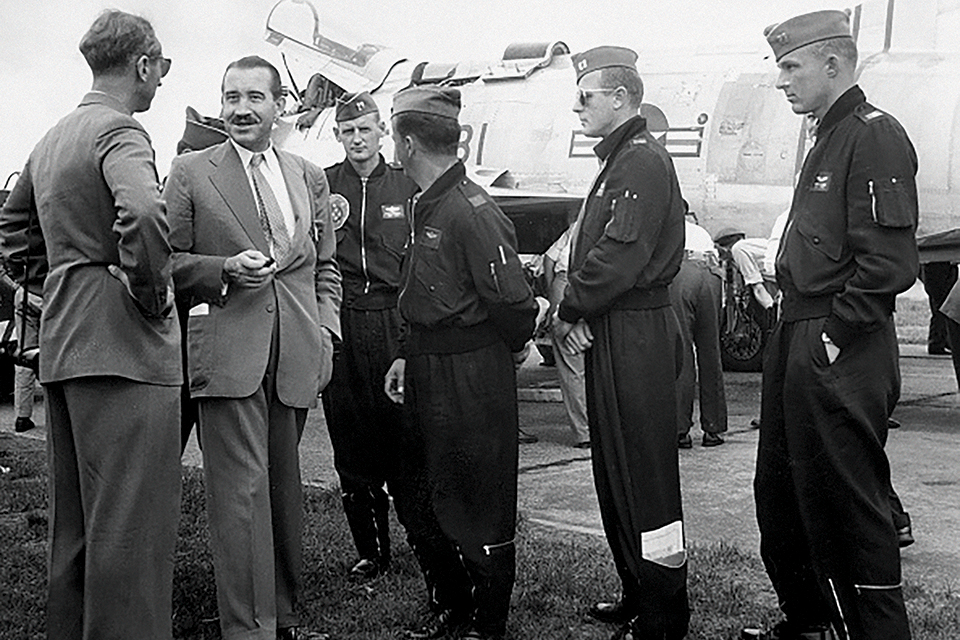
Lacking other options after his release, Galland worked as a forester and hunter on an estate in northern Germany. In 1948 he seized an opportunity to return to aviation when former Focke-Wulf engineer Kurt Tank invited him to join an enterprise in Argentina. Galland, who spoke Spanish from his Condor Legion days, called it one of the happiest periods of his life. He remained in Argentina until 1955, when he returned to Germany to pursue a business career.
Galland’s classic memoir, The First and the Last, was published in 1954 and widely translated, selling millions of copies worldwide. With a foreword by Douglas Bader, the book made the German ace an international celebrity and the recipient of hundreds of speaking invitations.
Meanwhile, Galland married three times, producing a son and daughter with his second wife. He met his last wife, Heidi Horn, via a flying club; they wed in 1984.
Galland traveled widely, becoming a social lion in Europe and America. During a California trip in 1979, historian Henry Sakaida introduced him to Jim Finnegan, who had shot down Galland during his last combat in April 1945. The former “Jug” pilot explained that the jet credited as damaged was his only claim of the war.
Galland sought to update The First and the Last, and found a sympathetic publisher in America. In 1986 Doug Champlin’s fighter aircraft museum in Mesa, Ariz., published the ultimate edition in combination with the photographic biography A Pilot’s Life.
By then Galland’s health was beginning to fade. Slowly his ability to travel degraded, and eventually he became bedridden. On February 9, 1996, he died at home in Oberwinter overlooking the Rhine, not quite 84.
Galland’s casket was borne by six Bundesluftwaffe wing commanders. As described by his biographer, David Baker, the elegy was delivered by Anton Weiler, president of the German Fighter Pilots Association: “He did not know the word lethargy. He left the slow ones behind. He was realistic but idealistic. He enjoyed resistance because it was a challenge. Self-confident, straightforward and at times impatient; always ahead of others and sometimes ahead of himself, he went a long way.”
As publisher at Champlin Fighter Museum Press, Barrett Tillman produced the final version of The First and the Last. His partnership with Adolf Galland afforded much of the perspective in this article. Additional reading: Adolf Galland: The Authorised Biography, by David Baker. See also this interview with Galland from our sister publication World War II.
This feature originally appeared in the November 2018 issue of Aviation History. Subscribe today!

